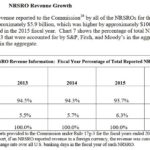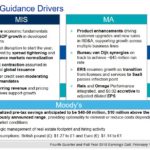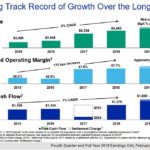Contents
Investors should consider Moody's Corporation (MCO) if interested in a high quality growth stock in which to invest for the long-term.
Summary
- Moody’s (MCO) occupies an enviable position with S&P Global at the heart of global financial markets.
- MCO lowered its guidance in Q3 2018 for the remainder of FY2018 and yet did not meet that lowered guidance when FY2018 results were released February 15, 2019.
- MCO typically generates gross margins in excess of 70% and operating margins in the 40s.
- Despite a weak bond issuance outlook MCO is projecting revenue growth and margin stability in 2019.
- MCO has just announced a ~13.6% increase in its quarterly dividend and a $0.5B accelerated share repurchase program that is expected to be completed during Q2 2019.
- I intend to increase my MCO exposure but will patiently wait for the valuation to retrace to a comparable level to that at which I initiated a position in late October 2018.
Introduction
In this recent article I indicated that 98.39% of the dollar value my overall holdings are held in 30 companies. Moody’s Corporation (NYSE: MCO) and S&P Global Inc. (NYSE: SPGI) are not within this group but I certainly intend to increase my exposure in these two companies when valuation is to my liking.
MCO has just released its Q4 and FY2018 results and since I analyzed SPGI in this recent article I view this as an opportune time to revisit MCO.
At the time of this March 4th SPGI article I viewed MCO and SPGI as somewhat expensive and indicated I would wait for a better valuation before initiating a position in them.
At the time of my October 26th MCO article, MCO had just released less than stellar Q3 results and the investment community hammered MCO’s stock price. Based on my review, however, I came to the conclusion that MCO’s valuation had reached a level where I was prepared to initiate a position for the ‘side accounts’ within the FFJ Portfolio. I acquired 250 MCO shares on October 26th at $143.61/share and subsequently MCO’s share price has risen over $25.50/share.
I also wrote a SPGI article on October 26th and indicated that I had also acquired 200 SPGI shares on October 25th at $175.8799; those shares have increased in value by ~$22.50/share.
Fast forward to February 15, 2019 and MCO has just released Q4 and FY2018 results that fall short of Wall Street estimates. MCO’s $169.26 share price, however, is $5.53/share, or 3.38%, higher than the close of the previous business day. Why?
Perhaps this has to do with MCO’s guidance for FY2019, the 13.6% increase in its quarterly dividend from $0.44/share to $0.50/share payable March 18th to shareholders of record on February 25th, a $0.5B accelerated share repurchase program that is expected to be completed during Q2 2019, and guidance for FY2019.
With all this recently provided information I now take this opportunity to look at MCO to determine whether this is an opportune time to acquire additional shares or whether I should patiently wait on the sidelines. Before doing so I provide the following Industry Overview.
Industry Overview
What has attracted me to this industry, and in particular, MCO and SPGI is that in 1936 the Office of the Comptroller of the Currency banned banks from holding bonds that were below investment grade (so…someone had to assess the credit quality of the bond issuers!). Then, in 1975, the SEC began using ratings in its rules (think that increased the importance of MCO and SPGI?).
As capital markets expanded globally and the variety and complexity of financial instruments grew, the importance in the role played by ratings agencies was reinforced by new regulations that designated "Nationally Recognized Statistical Ratings Organizations" (NRSROs) as the sole issuers of credit ratings for several purposes. In fact, the SEC specified that the only companies whose grades could be used were S&P, Moody’s, and Fitch.
This has ultimately led to what I view as a virtually insurmountable barrier for would-be competitors. In fact, in my March 3, 2018 MCO article to subscribers I provided an industry overview and indicated that MCO and SPGI are the two largest ratings agencies of the 10 NRSROs.
Even though the major ratings agencies failed miserably in properly identifying risk prior to the Financial Crisis, they have always been the clear market leaders since the inception of this industry.
In fact, years after faulty ratings helped trigger the worst financial crisis since the Great Depression and despite efforts by lawmakers to increase competition, MCO and SPGI are as dominant as ever; MCO and SPGI are in an enviable position because issuers are highly unlikely to find buyers for their bonds unless there are two ratings on those bonds.
Subsequent to the Financial Crisis, Morningstar entered the ratings business. It has, however, gained little market share as bond investors and regulators continue to use S&P, Moody’s and Fitch to measure risk.
Together, these 3 companies provide in excess of 90% of all credit ratings. Look at page 7 of 11 in this document. I recognize this study was published by the European Securities and Market Authority and focuses on the European market but nevertheless it is interesting to note that S&P, Moody’s and Fitch command a market share in excess of 93%.
If you are wondering why I like MCO and SPGI so much have a look at how dominant S&P, Moody’s and Fitch are in the US. There are several statistics starting on page 10 of 34 but in a nutshell, this is an oligopoly which is great for investors.
Source: SEC - Annual Report on Nationally Recognized Statistical Rating Organizations – December 2017
Roughly 4 decades ago, credit ratings agencies started charging for ratings services. The rationale they used was that objective ratings provided considerable value as ratings from these agencies tend to reduced information costs, increase an issuer's value in the market place, and increase the pool of possible borrowers. In a nutshell, the benefits provided by credit ratings agencies drill down to 1) improving access to capital and 2) reducing the costs of obtaining capital.
The reason why I like this oligopoly is that these firms do not compete on the basis of price. They look to compete based on the quality of their ratings and the value of their ratings.
These agencies know there are limited alternatives. In fact, if a rating is not provided by a highly respected ratings agency, the market notices this and the debt issuer’s cost of capital will rise. As is often the case, the cost of capital will rise to a far greater extent than the cost of obtaining the credit rating.
With MCO and SPGI being a ‘natural duopoly’, Berkshire Hathaway Inc., MCO’s largest shareholder, acquired a stake many years ago because of MCO’s pricing power.
Buffett has even gone on record to say ‘There are very few businesses that have the competitive position that MCO and SPGI have’. Pricing has no bearing on whether somebody is going to issue debt or not because the extra interest a borrower would have to pay on an unrated bond is significantly greater than the cost of a rating.
Credit ratings are not the only services provided by MCO and SPGI. If you are remotely interested in learning more about their respective lines of business, I highly encourage you to go directly to the first section of the most recent 10-K (MCO) and (SPGI); as I compose this article the most current version for MCO is the 2017 report while that for SPGI is the 2018 report.
Q4 and FY2018 Financial Results
In its July 27th Q2 Earnings Release, MCO reaffirmed its full year 2018 diluted EPS guidance of $7.20 - $7.40 and adjusted diluted EPS guidance of $7.65 - $7.85.
When Q3 results were released on October 26th, full year guidance was lowered to FY2018 diluted EPS of $6.95 - $7.10 and adjusted diluted EPS $7.50 - $7.65.
Final FY2018 results have now ended up being diluted EPS of $6.74 (up 31% from FY 2017) and adjusted diluted EPS of $7.39 (up 22% from FY 2017); MCO didn’t even meet its diluted EPS guidance which had been revised lower as recently as at the end of Q3/beginning of Q4.
I encourage you to quickly read MCO’s February 15, 2019 Earnings Release which explains in detail how MCO performed in its various lines of business and why it fell below recently amended guidance.
The Q4 and FY2018 Earnings Presentation that accompanies the Earnings Release can be found here.
FY2019 Outlook
MCO’s FY2019 Guidance can be found here.
At the Goldman Sachs Financial Services Conference on December 4th, MCO disclosed that it is enhancing the transparency around certain guidance metrics. At the same time it will be curtailing other metrics which are of lesser value or where they are inherently difficult to accurately predict. Starting in 2019, MCO is adding Moody’s Investors Service (MIS) MIS and Moody’s Analytics (MA) adjusted operating margin segment guidance, as well as net interest expense guidance; the REIS revenue guidance at the sub-segments or line of business level have been removed.
Source: MCO’s Q4 and FY2018 Earnings Presentation
Moody's outlook for 2019 is based on assumptions about many geopolitical conditions and macroeconomic and capital market factors, including but not limited to, interest in foreign currency exchange rates, corporate profitability and business investment spending, mergers and acquisition, and the level of debt capital markets activity.
The plan is to:
- Deepen MCO’s role in serving risk-sensitive markets by expanding down the credit pyramid;
- Selectively expand in adjacent and / or emerging risk areas;
- Become increasingly grounded in technology-enabled products, services and capabilities.
Source: MCO’s Q4 and FY2018 Earnings Presentation
The following images reflect a variety of drivers MCO has considered when setting up 2019 guidance. There are several additional pages in the Q4 and FY2018 Earnings Presentation that provide more detail on MCO’s projections but in a nutshell, the key takeaways are revenue growth and margin stability in 2019 despite a weaker bond issuance outlook.
Source: MCO’s Q4 and FY2018 Earnings Presentation
Valuation
Following the release of Q2 results on July 27th, MCO closed at $176.60. Using the guidance provided at the time, MCO’s forward PE based on diluted EPS was expected to be in the range of ~23.86 - ~25.53 and ~22.5 - ~23.08 based on forward adjusted diluted EPS.
MCO shares were exchanging hands at $141.63 as at the close of business on October 26th. I determined that MCO’s forward PE based on revised diluted EPS was expected to be in the range of ~19.95 - ~20.38 and ~18.5 - ~18.88 based on revised forward adjusted diluted EPS.
We now see that MCO has generated FY2018 diluted EPS of $6.74 and adjusted diluted EPS of $7.39 and with shares trading hands at $169.26 we get a diluted PE of ~25.11 and an adjusted diluted PE of ~22.9.
MCO has now provided diluted EPS guidance of $7.30 - $7.55 ($7.425 mid-point) and adjusted diluted EPS guidance of $7.85 - $8.10 ($7.975 mid-point). Using MCO’s $169.26 share price we get a forward diluted PE of ~22.8 and a forward adjusted diluted PE of ~21.22.
MCO’s current valuation and valuation based on guidance makes it more expensive than when I recommended it as an investment in October.
Credit Ratings
MCO’s credit ratings assigned by SPGI and Fitch continue to be BBB+; this is a lower medium grade credit rating.
Cash Flow Generation and Free Cash Flow (FCF)
At FYE2018, MCO had ~$5.7B of outstanding debt, total cash, cash equivalents and short-term investments of ~$1.8B, and ~$1B of additional borrowing capacity under its revolving credit facility.
On January 3, 2019, just subsequent to MCO’s fiscal year end, it repaid ~$0.45B of 2014 Senior Notes with proceeds from its December 2018 bond offering. This left it with ~$5.3B of outstanding debt and total cash, cash equivalents and short-term investments of ~$1.4B.
Source: MCO’s Q4 and FY2018 Earnings Presentation
Free cash flow in 2018 was ~$1.37B, an increase from ~$0.664B in 2017. The increase is primarily due to payments MCO made in Q1 2017 pursuant to its 2016 settlement with the Department of Justice and various states attorneys general.
I view MCO’s current FCF as acceptable.
Dividend, Dividend Yield, and Dividend Payout Ratio
MCO’s dividend history can be found here.
When I wrote my October 26th article, MCO had closed at $141.63 and the current $0.44/quarter dividend ($1.76 annually) provided investors with a ~1.24% dividend yield.
The quarterly dividend has now been increased to $0.50 ($2.00/year) and MCO is trading at $169.26 as at the close of business on February 15, 2019. This gives us a forward dividend yield of ~1.18%; the yield is even lower than at the time of my previous article.
Investors who passed on MCO at the time of my last article because they were fixated on the low dividend yield will likely have little interest in MCO now. MCO’s share price would have to drop to ~$161.30 just so the current dividend yield reaches 1.24%.
The new $2 annual dividend is a ~30% payout ratio on the basis of FY2018 EPS of $6.74.
If we use the mid-point of 2019 guidance, diluted EPS of $7.425 and adjusted diluted EPS of $7.975, the dividend payout ratio is ~27% and ~25%.
I was not expecting the dividend payout ratio to be high since MCO is not viewed as a dividend income stock and view the dividend payout ratio as acceptable.
The diluted weighted average number of shares outstanding in FY2017 was 194.2 million versus 195.4 million in FY2016. This compares very favorably with the 291.9 million diluted weighted average number of shares outstanding in FY2006.
I encourage you to quickly look at the 2018 Capital Allocation & Liquidity section of MCO’s February 15, 2018 Earnings Release (page 6 of 24). In that section MCO discloses the number of shares repurchased in 2018 and at what average cost.
At the end of FY2018 the shares outstanding have been reduced to 191.6 million and 194.4 million. I am puzzled by this drop from FY2017 levels given that in MCO’s February 15, 2018 Earnings Release we see that MCO repurchased 1.2 million shares at an average cost of $163.93 in FY2018 and issued a net 1.5 million shares as part of its employee stock-based compensation plan.
Keep in mind MCO’s recent announcement of a $0.5B accelerated share repurchase program that is expected to be completed during Q2 2019.
Final Thoughts
I like that MCO and SPGI each hold a sizable market share of the ratings industry but that they are not limited to just this line of business; they essentially have a captive audience to which they can cross-sell all their other services.
I fully understand Warren Buffett’s logic in owning fewer than 20 million MCO shares; this figure has been obtained from the most recent Form 13F filing.
In addition, Chris Hohn (TCI Fund Management) owns a sizable stakes in MCO; he acquired just fewer than 4 million MCO shares in Q4 2018.
If MCO is good enough for these two highly sophisticated investors then it is good enough for me. I am, however, reluctant to acquire additional shares at the current valuation.
I mentioned in my October 26th MCO article that business is certainly cyclical and the time to invest in these companies is when investor sentiment is low. This certainly does not seem to be the case at the moment and I am of the opinion many investors have completely forgotten how market values can turn on a dime (despite this having occurred in December 2018).
Here we have a company that lowered full-year guidance in Q3 and didn’t meet lowered guidance when it released FY2018 results yet the forward diluted PE of ~22.8 and the forward adjusted diluted PE of ~21.22 are greater than when MCO released weaker Q3 results.
I would like shares to retrace to, or at least close to, the valuation when I purchased shares in October. This would mean that MCO’s shares would need to drop to ~$150 thus giving us a diluted PE of ~20.2 on the basis of MCO’s $7.425 diluted EPS mid-point projection. The ~20.2 level is MCO’s mid-point of the ~19.95 - ~20.38 diluted PE range when I purchased shares in October.
I wish you much success on your journey to financial freedom.
Thanks for reading!
Note: I sincerely appreciate the time you took to read this article. Please send any feedback, corrections, or questions to [email protected].
Disclaimer: I have no knowledge of your individual circumstances and am not providing individualized advice or recommendations. I encourage you not to make any investment decision without conducting your own research and due diligence. You should also consult your financial advisor about your specific situation.
Disclosure: I am long MCO and SPGI.
I wrote this article myself and it expresses my own opinions. I am not receiving compensation for it and have no business relationship with any company whose stock is mentioned in this article.









